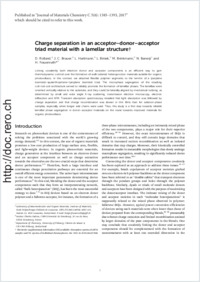Charge separation in an acceptor–donor–acceptor triad material with a lamellar structure
- Rolland, Damien Laboratory of Macromolecular and Organic Materials, Institute of Materials, Ecole Polytechnique Fédérale de Lausanne, Switzerland
- Brauer, Jan C. Laboratory of Macromolecular and Organic Materials, Institute of Materials, Ecole Polytechnique Fédérale de Lausanne, Switzerland
- Hartmann, Lucia Laboratory of Macromolecular and Organic Materials, Institute of Materials, Ecole Polytechnique Fédérale de Lausanne, Switzerland
- Biniek, Laure Institut Charles Sadron, CNRS-Université de Strasbourg, France
- Brinkmann, Martin Institut Charles Sadron, CNRS-Université de Strasbourg, France
- Banerji, Natalie Department of Chemistry, University of Fribourg, Switzerland
- Frauenrath, Holger Laboratory of Macromolecular and Organic Materials, Institute of Materials, Ecole Polytechnique Fédérale de Lausanne, Switzerland
-
09.02.2017
Published in:
- Journal of Materials Chemistry C. - 2017, vol. 5, no. 6, p. 1383–1393
English
Linking covalently both electron donor and acceptor components is an efficient way to gain thermodynamic control over the formation of well-ordered heterojunction materials suitable for organic photovoltaics. In this context, we attached flexible polymer segments to the termini of a (perylene bisimide)–quaterthiophene–(perylene bisimide) triad. The microphase segregation of the resulting coil-rod-coil architecture served to reliably promote the formation of lamellar phases. The lamellae were oriented vertically relative to the substrate, and they could be laterally aligned by mechanical rubbing, as determined by small and wide angle X-ray scattering, transmission electron microscopy, electron diffraction and AFM. Transient absorption spectroscopy revealed that light absorption was followed by charge separation and that charge recombination was slower in thin films than for solution-phase samples, especially when longer side chains were used. Thus, this study is a first step towards reliable lamellar phase segregation in donor–acceptor materials on the route towards improved materials for organic photovoltaics.
- Faculty
- Faculté des sciences et de médecine
- Department
- Département de Chimie
- Language
-
- English
- Classification
- Chemistry
- License
-
License undefined
- Identifiers
-
- RERO DOC 288568
- DOI 10.1039/C6TC03786K
- Persistent URL
- https://folia.unifr.ch/unifr/documents/305434
Other files
Statistics
Document views: 82
File downloads:
- pdf: 142
- Supplementary material: 126

